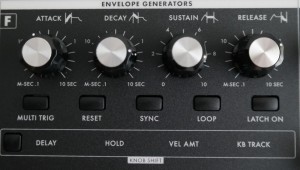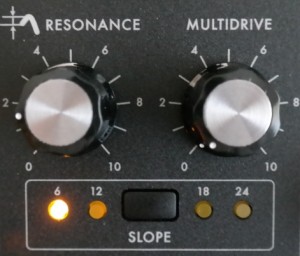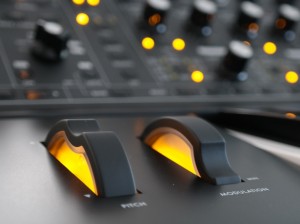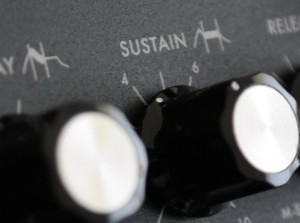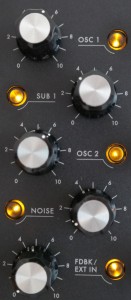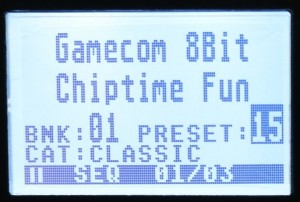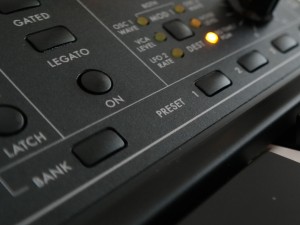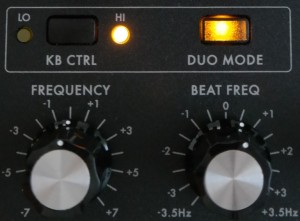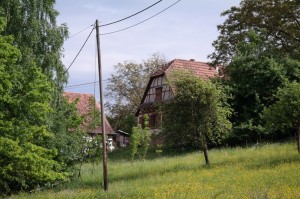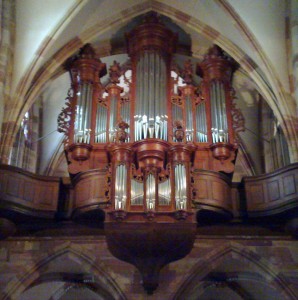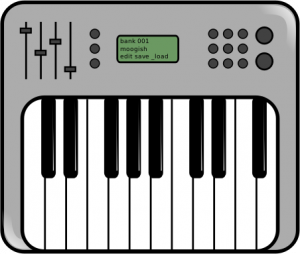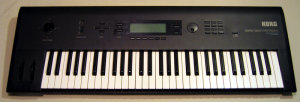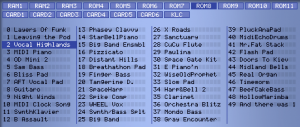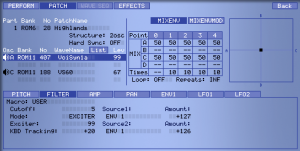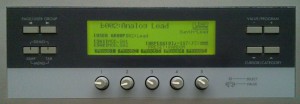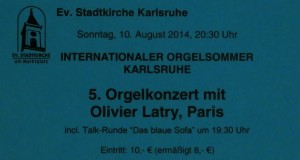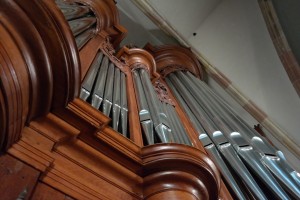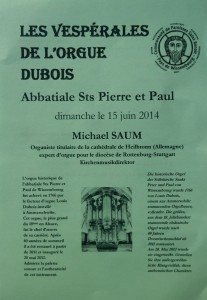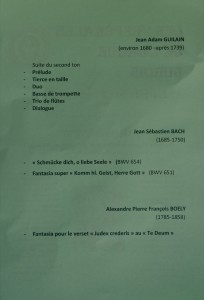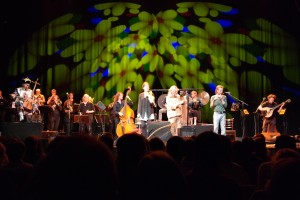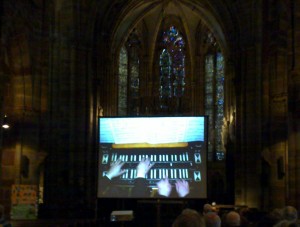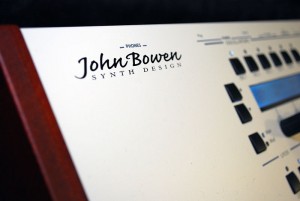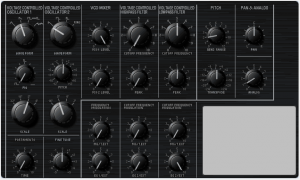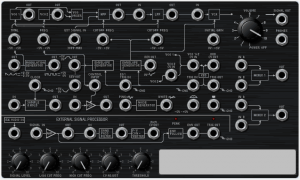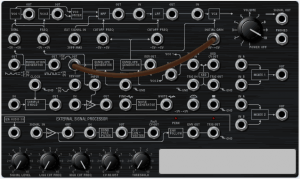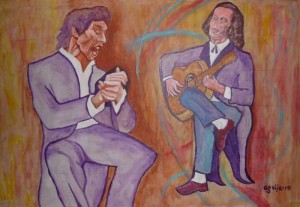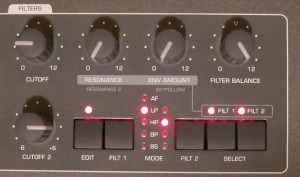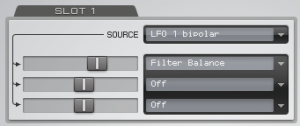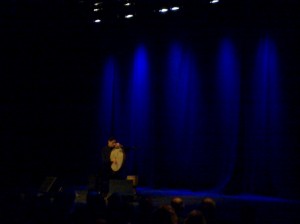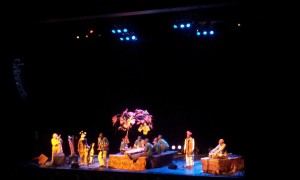Seit ich mit Synthesizern spiele, sind es Digitalmaschinen. Nun, stimmt nicht ganz. Der Microwave aus dem Jahre 1989 war teilweise noch analog aufgebaut, insbesondere die Curtis-Filter. Dennoch habe ich glorreichen 1970er Jahre mit diversen Moogs, Oberheims, ARPs und so weiter nicht aktiv miterlebt. Dennoch bin ich musikalisch geprägt von der Musik jener Zeit, ganz egal ob Keith Emerson, Chick Corea, Joe Zawinul oder Jan uns haben hören lassen, “wo der Hammer hängt”.
Ich lese gelegentlich, der Minimoog sei nach wie vor das Maß der Dinge. Umso erstaunlicher, dass seitdem kein Gerät den Klang wirklich emulieren konnte – auch nicht die vielen “Virtual Analog”-Synthesizer bzw. Softwareemultationen, die seit den 1990er Jahren entstanden sind.
Gestern hatte ich “zufällig” die Gelegenheit (der Zufall hieß Regen), beim Musikalienhändler des Vertrauens eine der aktuellen Analogkisten zu begutachten. Seit ein paar Jahren baut Moog wieder Synthesizer, allen voran den Minimoog Voyager, der allerdings preislich jenseits aller Vernunft liegt. Parallel dazu werden seit 2006 abgespeckte Varianten angeboten, bekannt als Phattys (Little Phatty, Slim Phatty und Sub Phatty).
Sub 37 – Kurzüberblick
Der jüngste Synthesizer dieser Serie ist der im Januar 2014 angekündigte Sub 37. Musste man bei den Vorgängermodellen oftmals noch in das Softwaremenü absteigen, hat Moog hier versucht, so viel wie irgend möglich direkt über die Frontplatte zugänglich zu machen. Die Tastatur bietet einen Umfang von drei Oktaven (wobei die Tasten geringfügig schmaler und kürzer ausfallen als üblich), und Moog hat auch bei den Leistungmerkmalen sehr vieles spendiert, um den Klangerzeuger möglichst appetitlich zu machen. So finden sich hier ein leistungsfähiger Arpeggiator, zwei Niederfrequenzoszillatoren (LFOs), zwei Oszillatoren nebst Suboszillator, einen Tiefpassfilter mit wählbarer Flankensteilheit zu 6, 12, 18 oder 24 db pro Oktave, einen neu entwickelten “Multidrive” und ausgefuchste Hüllkurven.
Hardware
Sehr wertig. Die von mir gespielte Version hört auf den Namen “Tribute Edition”. Es handelt sich um eine limitierte Sonderauflage zu Ehren von Robert Moog, die unter anderem mit Seitenwangen aus Massivholz (statt später Kunststoff) ausgestattet ist. Ein Teil der Verkaufserlöse soll an Schulmusikprogramme gespendet werden.
Erwähnenswert ist das eingebaute Netzteil. Die Stromversorgung erfolgt somit über ein Standard Kaltgerätekabel. Sehr schön. Alle Anschlüsse sind in einem Ausschnitt der linken Seitenwange untergebracht. Enthalten ist auch eine USB-Schnittstelle, über die sehr wohl MIDI-, aber keine Audiodaten übertragen werden können. Die einzige Ausnahme bildet der Kopfhöreranschluss mit dediziertem Lautstärkeregler, der auf der Frontplatte untergebracht ist. Nicht optimal, da das Kabel unweigerlich über den obersten Tasten hängt, aber ich werde sowieso eher selten mit Kopfhörer spielen.
Fast alle Drucktaster der Frontplatte sind hinterleuchtet und zeigen somit stets den aktuellen Status an. Auch die beiden Handräder sind illuminiert.
Die Handräder sind auch sehr angenehm und leicht zu spielen. Allerdings weiß ich seit Jahren den Roland-Jammerhaken bzw. den Korg-Joystick zu schätzen. Beide gestatten Spielweisen, die mit Rädern gar nicht (oder ungleich schwieriger) umzusetzen sind. Falls jemand einen externen Joystick mit MIDI- oder gleich USB-Anschluss findet, bitte ich kurz um Info.
Die Drehschalter bzw. -potentiometer sind auf der Oberseite mit Metall belegt, was die Orientierung bei schlechten Beleuchtungsverhätnissen extrem erleichtert. Eine weiteres Detail findet sich an den Potentiometern, die eine Markierung oben und unten besitzen. Ablesefehler durch Parallaxe werden dadurch reduziert.
Die Bedienelemente des Sub 37 sind ein wahrhaft opulenter Genuss. Der einzige kleine Kritikpunkt ist der, dass Moog die Drucktaster in der Größe schrumpfen musste, um sie alle unterzubringen. An der ein oder anderen Stelle muss man somit etwas genauer “zielen”.
Als extrem nützlich habe ich die “Mute”-Taster in der Mixersektion empfunden. Einzelne Klangquellen lassen sich so schnell an- und abschalten, ohne das Mischungsverhältnis zu ändern, um die anderen einer Prüfung unterziehen zu können. Das ist äußerst nützlich und eine Sache, die sich ähnlich am Korg Z1 findet, während mich am Access Virus immer wieder stört, dass ich nicht mal eben schnell Oszillator 1, 2, oder gar 3 vereinzeln kann.
Das Display ist ungewöhnlicherweise nicht zentral untergebracht, sondern links oben. Auch ist es anders aufgebaut, als die üblichen 2×16 Zeichen Displays. Ich persönlich empfinde es als äußerst angenehm, mal was anderes zu sehen, als die übliche Massenstandardkost.
Die Holzseitenteile (es dürfte sich um Esche handeln) waren hoffentlich vor der Fertigung auf rund 10 % Holzfeuchte heruntergetrocknet. Andernfalls würde ich ob der Nuten und Passungen mit den Aluminiumteilen erwarten, dass Schwundrisse entstehen werden.
Zwei Schwachstellen wies das von mir bespielte Ausstellungsstück auf. Das höchste D# war um etwa 5 Grad gegen die Vertikale geneigt, und die MIDI-Out-Buchse war außermittig montiert, so dass ich bezweifle, dass sich ein MIDI-Kabel tatsächlich hätte einstecken lassen. Insofern empfehle ich Käufern, die Hardware initial einem ausgiebigen Test zu unterziehen.
Presets
Der Sub 37 bietet jeweils 16 Klänge organisiert in 16 Bänken. Insgesamt stehen somit 256 Speicherplätze zur Verfügung. Bis Bank 9, Platz 6 sind diese bereits mit 134 Klängen vorbelegt. 122 Speicherplätze können somit für eigene Klänge genutzt werden, ohne dass Teile der mitgelieferten Klänge überschrieben werden müssen.
Auf der Frontplatte finden sich 16 Taster, über die die 16 Bänke und die jeweils 16 Programme direkt aufrufbar sind. Hier wäre auch einer meiner minimalen Kritikpunkte: Ein “Favoritenmodus”, in dem man auf die 16 Taster die am häufigsten benötigten Klänge legen kann, wäre super gewesen.
LFOs und Modulationsbusse
Die beiden LFOs sind jeweils in einer Modulationssektion untergebracht. Über einen Wahlschalter können die verschiedenen Wellenformen gewählt werden. In der sechsten Stellung jedoch, die mit “F. EG/PGM” bezeichnet ist, wird die LFO-Wellenform deaktiviert. Stattdessen kann man über das Menü eine Quelle (unter anderem Velocity oder Key Tracking ) wählen.
Jeder der beiden Busse kann bis zu drei Parameter steuern. Zwei davon sind hart verdrahtet (Pitch und Filter). Der dritte kann aus vorgegebenen Zielen gewählt werden, oder (in der letzten Stellung) einen über das Menü auswählbaren Parameter (wie beispielsweise Hüllkurvenzeiten) steuern.
Über das Menü kann zusätzlich festgelegt werden, wie stark die Steuerinformationen über das Modulationsrad oder die Nachdruckstärke beeinflusst werden soll.
Wirklich sehr flexibel gelöst. In Asheville scheinen Ingenieure zu sitzen, die mit Leidenschaft zu Werke gehen.
Wenn dem Sub 37 etwas fehlt, dann ist es eine dritte Hüllkurve. Da es sich um einen monophonen Synthesizer handelt, sind Bass- und vor allem Leadsounds sein natürliches Habitat. Und für letztere fehlt mir die Möglichkeit, ein Vibrato einblenden oder Stab-Sounds erstellen zu können. Dafür kann man die Filter-Hüllkurve entleihen, aber sie dann eben nicht mehr exklusiv für den Filter nutzen.
Paraphonie
Der Sub 37 ist eigentlich monophon. Man kann ihn aber im “Duo Mode” betreiben, so dass man ihn auch zweistimmig spielen kann. Ich habe das ob der Kürze der Zeit nicht ausgiebig testen können, aber es ergeben sich dadurch Möglichkeiten für interessante Spieltechniken.
Klang
Auch wenn ich keinen direkten Vergleich anstellen konnte, würde ich behaupten, er klingt nicht nach Minimoog. Auch treffen die Werkpresets nur sehr bedingt meinen Geschmack. Andererseits klingt die Kiste unverwechselbar nach Moog. Sobald man am Filter und der Filterhüllkurve schraubt stellt sich unmittelbar der “Boah”-Effekt ein. Cremig, sahnig, wie auch immer. Bei Digitalkisten erlebe ich selten, dass mich bereits ein Oszillator alleine durch einen Tiefpassfilter gejagt beeindruckt. Hier ist das der Fall. Zudem klingt der Sub 37 bereits ohne Effekte sehr sehr gut. Bei Digitalkisten muss ich meist erstmal mit Effekten nachhelfen, damit der Klang Freude bereitet.
Preis
Durch den Dollarkurs sind die Preise für Moog-Synthesizer kürzlich enorm angestiegen. Gab es den Minimoog Voyager XL vor kurzen noch für rund 4600 €, sind mittlerweile knapp 6000 € fällig. Der Sub 37 stieg von rund 1500 € auf 1800 €. Viele Käufer werden also abwarten, wie sich der Euro-Kurs weiter entwickelt.
Fazit
Unter den Phattys ist der Sub 37 jedenfalls das Gerät, das am meisten Spielfreude verspricht. Logischer Aufbau, fast alles in direktem Zugriff, phantastisch klingende Oszillatoren und Filter, sehr schönes Design. Wenn das Gerät im Moment nicht so teuer wäre, würde ich es jedem Synthesizerenthusiasten wärmstens ans Herz legen. Alternativ kann man natürlich abwarten, bis die ersten Sub 37 auf dem Gebrauchtmarkt erscheinen.
Resourcen
- Review von Mike Huckaby
- Video und Soundset von Marcus Padrini
- Ein Blick ins Innere von Markus Fuller

